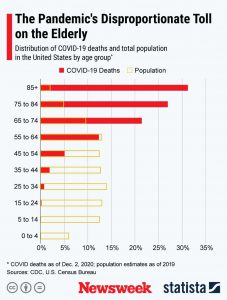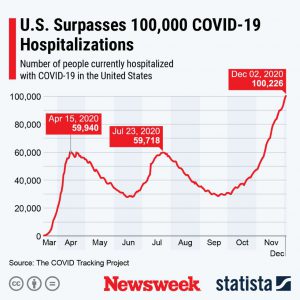DECEMBER 5, 2020

Dr. Anthony Fauci, the director of the National Institute of Allergy and Infectious Diseases, speaks during a White House Coronavirus Task Force press briefing at the White House on November 19. – Brendan Smialowski/AFP via Getty Images
The U.S. COVID-19 outbreak will “get worse before it gets better” and the country won’t see “dramatic changes” until the third quarter of next year, Dr. Anthony Fauci told Newsweek.
Speaking to Newsweek, the director of the National Institute of Allergy and Infectious Diseases (NIAID) and member of the White House COVID-19 task force said: “I think the decreases are going to start as we get into April and as more of the general population gets vaccinated.
“Then as you get to May, June and July, towards the end of the second quarter of 2021, I think you’re going to start seeing some dramatic changes as we go into the third quarter.
Noting the country “never got out of the first wave” of the COVID-19 outbreak, Fauci explained: “I don’t even talk in waves anymore [when describing the outbreak]. I see it more like a high background with different surges super-imposed upon it, as opposed to a wave that comes and goes.”
Is there hope for this virus to get under control? “Oh absolutely, yes. But it’s going to get worse before it gets better because we’re having these surges now that are not going to be impacted by the vaccine for at least a few months.
“We’re not going to see that [a dramatic decline] for the next couple of months, because the next couple of months are going to be reflecting what’s happening out and what happened a few weeks ago [in terms of rising cases].
“If people take the vaccine, we could go a long way to really diminishing dramatically [in cases] as we get into the second and third quarter of 2021. Then I think you’ll start to see a dramatic diminishing of cases.”
As COVID-19 hospitalizations soar across the country, Fauci told Newsweek “it’s entirely conceivable that January could be the worst” stage of the outbreak.
“I think January is gonna be terrible, because you’re gonna have the Thanksgiving surge super-imposed upon the Christmas surge.”
The country’s daily case count is estimated to peak on January 20, if “vaccination distribution is scaled up over 90 days and “governments do not re-impose mandates if cases increase,” according to the latest projection from the Institute for Health Metrics and Evaluation (IHME).
The daily case tally could is projected to be around 448,000 on January 20, if “vaccine distribution is scaled up for 45 days,” according to the IHME.
Over 100,600 COVID-19 patients were reported to be hospitalized as of Thursday, according to data compiled by The Atlantic‘s COVID Tracking Project.
According to forecasts received by the U.S. Centers for Disease Control and Prevention (CDC) from 12 modeling groups, “For December 28, the forecasts estimate 2,300 to 23,000 new COVID-19 hospitalizations per day.
“Four national forecasts predict a likely increase in the number of new hospitalizations per day over the next four weeks, one forecast predicts a likely decrease, and four forecasts are uncertain about the trend or predict stable numbers.”
“State-level forecasts also show a high degree of variability, which results from multiple factors. Hospitalization forecasts use different sources of data for COVID-19 cases or deaths, with different limitations, and make different assumptions about social distancing,” said a CDC report published Wednesday.
The wider picture
The novel coronavirus has infected more than 65.4 million people since it was first reported in Wuhan, China.
More than 1.5 million people have died worldwide and more than 42 million have recovered as of Friday, according to Johns Hopkins University.
The graphic below, provided by Statista, shows the distribution of COVID-19 deaths among the U.S. population.

The graphic below, produced by Statista, shows the number of current COVID-19 hospitalizations in the U.S.

Courtesy/Source: Newsweek

































































































